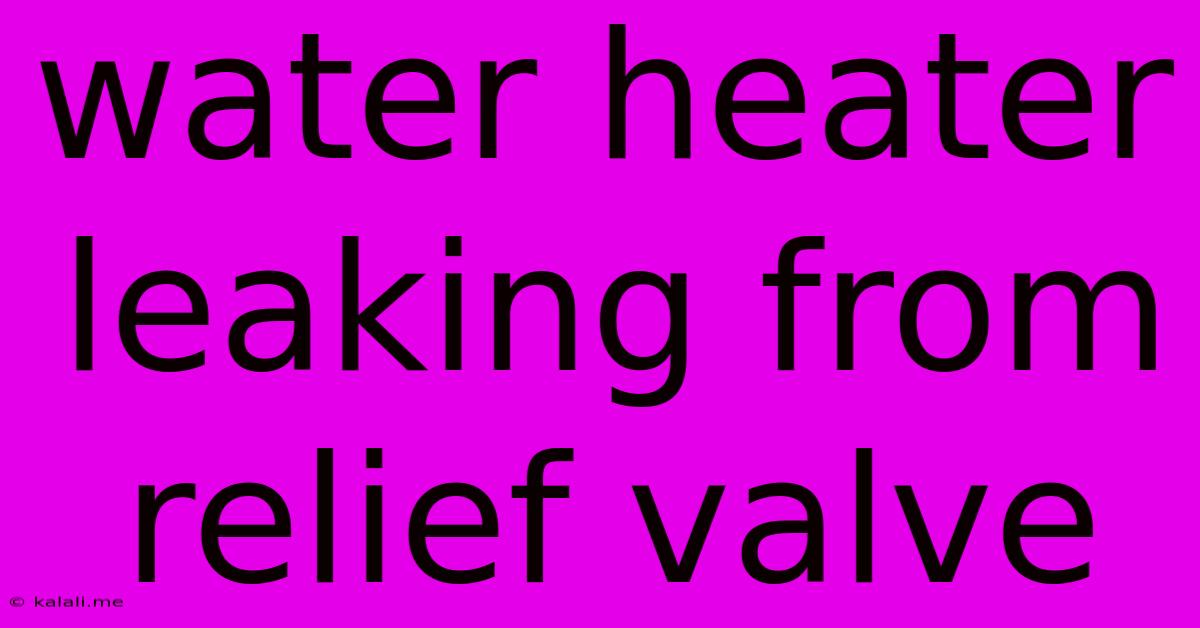Water Heater Leaking From Relief Valve
Kalali
May 23, 2025 · 3 min read

Table of Contents
Water Heater Leaking From Relief Valve: Causes, Solutions, and Prevention
A leaky water heater relief valve can be a real headache. Not only is it inconvenient, but it also points to a potential safety hazard and significant water waste. This article will guide you through understanding why your water heater is leaking from the relief valve, how to fix it, and most importantly, how to prevent future issues.
Understanding the Relief Valve
The temperature and pressure relief (T&P) valve is a crucial safety device on your water heater. Its job is to prevent dangerous pressure buildup inside the tank. If the pressure exceeds the valve's setting (typically 150 PSI), it automatically opens, releasing hot water to relieve the pressure. A leak from this valve usually indicates an underlying problem, not a faulty valve itself.
Common Causes of a Leaky Relief Valve
Several factors can cause your water heater's relief valve to leak. These include:
- Excessive Water Pressure: This is the most common culprit. High water pressure forces water past the valve's seal, resulting in a constant drip or even a steady stream. You might notice other plumbing fixtures behaving unusually as well.
- Temperature and Pressure Buildup: A malfunctioning thermostat or heating element can cause the water to overheat, increasing pressure beyond the relief valve's capacity. Sediment buildup within the tank can also contribute to this issue.
- Faulty Relief Valve: While less common, the valve itself can fail, becoming worn or damaged over time. A faulty valve might not close properly, leading to a persistent leak.
- Sediment Buildup: Mineral deposits and sediment can accumulate within the water heater tank. This buildup can restrict water flow and cause pressure to increase, triggering the relief valve.
- Expansion Tank Issues (if applicable): If your system uses an expansion tank to manage pressure fluctuations, a malfunctioning tank can overwork the T&P valve.
Troubleshooting and Solutions
Before attempting any repairs, remember to turn off the power or gas supply to your water heater. Safety should always be your top priority.
Here's a step-by-step troubleshooting process:
-
Check Water Pressure: Use a pressure gauge to measure the water pressure at a cold water tap. If it's above 80 PSI, you likely have high water pressure. Contact a plumber to install a pressure regulator to reduce it to the ideal range (40-60 PSI).
-
Inspect the Relief Valve: Check the valve for any visible damage or corrosion. A simple visual inspection might reveal a faulty valve requiring replacement.
-
Check the Temperature and Pressure Gauge (if applicable): If your water heater has a gauge, monitor the temperature and pressure readings. High readings suggest potential issues with the heating elements or thermostat. Consult a professional for further diagnosis.
-
Flush the Water Heater: Regularly flushing your water heater can remove sediment buildup, preventing pressure buildup and potential leaks. This is a preventative measure that can be done yourself, following instructions specific to your water heater model.
Preventing Future Leaks
Regular maintenance is key to preventing a leaky relief valve. Consider these preventative measures:
- Annual Inspections: Schedule annual inspections of your water heater by a qualified plumber.
- Regular Flushing: Flush your water heater at least once a year to remove sediment.
- Pressure Gauge Monitoring: Regularly check the water pressure in your home.
- Addressing Leaks Promptly: Repair any minor leaks immediately to prevent them from escalating.
When to Call a Plumber
If you're uncomfortable performing any of these steps, or if the problem persists after attempting the troubleshooting steps, contact a qualified plumber. A leaky relief valve can indicate more serious underlying problems requiring professional attention. Ignoring the issue can lead to water damage, higher energy bills, and safety risks.
By understanding the causes of a leaky relief valve and following these preventative steps, you can ensure the longevity and safety of your water heating system. Remember, a well-maintained water heater is a safer and more efficient water heater.
Latest Posts
Latest Posts
-
Origins Of The Phrase Hang Tight
May 23, 2025
-
Assign Salesforce Custom Object Record To Group
May 23, 2025
-
Can Checks Be Sent Through Email
May 23, 2025
-
Taylor Series 1 1 X 2
May 23, 2025
-
How To Quote Song Lyrics On Social Media
May 23, 2025
Related Post
Thank you for visiting our website which covers about Water Heater Leaking From Relief Valve . We hope the information provided has been useful to you. Feel free to contact us if you have any questions or need further assistance. See you next time and don't miss to bookmark.